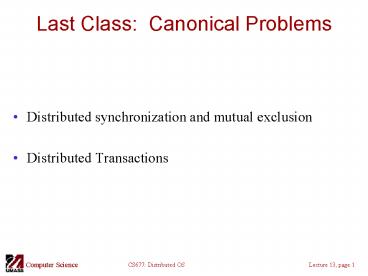Last Class: Canonical Problems - PowerPoint PPT Presentation
Title:
Last Class: Canonical Problems
Description:
Achieve consistency by ensuring data items are accessed in an specific order ... If Ti wants to do an operation that conflicts with Tj. Abort Ti if ts(Ti) ts(Tj) ... – PowerPoint PPT presentation
Number of Views:19
Avg rating:3.0/5.0
Title: Last Class: Canonical Problems
1
Last Class Canonical Problems
- Distributed synchronization and mutual exclusion
- Distributed Transactions
2
Today Concurrency Control
- Concurrency control
- Two phase locks
- Time stamps
- Intro to Replication and Consistency
- Thoughts on the mid-term
3
Concurrency Control
- Goal Allow several transactions to be executing
simultaneously such that - Collection of manipulated data item is left in a
consistent state - Achieve consistency by ensuring data items are
accessed in an specific order - Final result should be same as if each
transaction ran sequentially - Concurrency control can implemented in a layered
fashion
4
Concurrency Control Implementation
- General organization of managers for handling
transactions.
5
Distributed Concurrency Control
- General organization of managers for handling
distributed transactions.
6
Serializability
BEGIN_TRANSACTION x 0 x x 1END_TRANSACTION (a) BEGIN_TRANSACTION x 0 x x 2END_TRANSACTION (b) BEGIN_TRANSACTION x 0 x x 3END_TRANSACTION (c)
Schedule 1 x 0 x x 1 x 0 x x 2 x 0 x x 3 Legal
Schedule 2 x 0 x 0 x x 1 x x 2 x 0 x x 3 Legal
Schedule 3 x 0 x 0 x x 1 x 0 x x 2 x x 3 Illegal
- Key idea properly schedule conflicting
operations - Conflict possible if at least one operation is
write - Read-write conflict
- Write-write conflict
7
Optimistic Concurrency Control
- Transaction does what it wants and validates
changes prior to commit - Check if files/objects have been changed by
committed transactions since they were opened - Insight conflicts are rare, so works well most
of the time - Works well with private workspaces
- Advantage
- Deadlock free
- Maximum parallelism
- Disadvantage
- Rerun transaction if aborts
- Probability of conflict rises substantially at
high loads - Not used widely
8
Two-phase Locking
- Widely used concurrency control technique
- Scheduler acquires all necessary locks in growing
phase, releases locks in shrinking phase - Check if operation on data item x conflicts with
existing locks - If so, delay transaction. If not, grant a lock on
x - Never release a lock until data manager finishes
operation on x - One a lock is released, no further locks can be
granted - Problem deadlock possible
- Example acquiring two locks in different order
- Distributed 2PL versus centralized 2PL
9
Two-Phase Locking
- Two-phase locking.
10
Strict Two-Phase Locking
- Strict two-phase locking.
11
Timestamp-based Concurrency Control
- Each transaction Ti is given timestamp ts(Ti)
- If Ti wants to do an operation that conflicts
with Tj - Abort Ti if ts(Ti) lt ts(Tj)
- When a transaction aborts, it must restart with a
new (larger) time stamp - Two values for each data item x
- Max-rts(x) max time stamp of a transaction that
read x - Max-wts(x) max time stamp of a transaction that
wrote x
12
Reads and Writes using Timestamps
- Readi(x)
- If ts(Ti) lt max-wts(x) then Abort Ti
- Else
- Perform Ri(x)
- Max-rts(x) max(max-rts(x), ts(Ti))
- Writei(x)
- If ts(Ti)ltmax-rts(x) or ts(Ti)ltmax-wts(x) then
Abort Ti - Else
- Perform Wi(x)
- Max-wts(x) ts(Ti)
13
Pessimistic Timestamp Ordering
- Concurrency control using timestamps.
14
Replication
- Data replication common technique in distributed
systems - Reliability
- If one replica is unavailable or crashes, use
another - Protect against corrupted data
- Performance
- Scale with size of the distributed system
(replicated web servers) - Scale in geographically distributed systems (web
proxies) - Key issue need to maintain consistency of
replicated data - If one copy is modified, others become
inconsistent
15
Object Replication
- Approach 1 application is responsible for
replication - Application needs to handle consistency issues
- Approach 2 system (middleware) handles
replication - Consistency issues are handled by the middleware
- Simplifies application development but makes
object-specific solutions harder
16
Replication and Scaling
- Replication and caching used for system
scalability - Multiple copies
- Improves performance by reducing access latency
- But higher network overheads of maintaining
consistency - Example object is replicated N times
- Read frequency R, write frequency W
- If RltltW, high consistency overhead and wasted
messages - Consistency maintenance is itself an issue
- What semantics to provide?
- Tight consistency requires globally synchronized
clocks! - Solution loosen consistency requirements
- Variety of consistency semantics possible
17
Mid-term Exam Comments
- Closed book, closed notes, 90 min
- Lectures 1-13 included on the test
- Focus on things taught in class (lectures,
in-class discussions) - Start with lecture notes, read corresponding
sections from text - Supplementary readings (key concepts) included on
the test. - Exam structure few short answer questions, mix
of subjective and design questions - Good luck!































